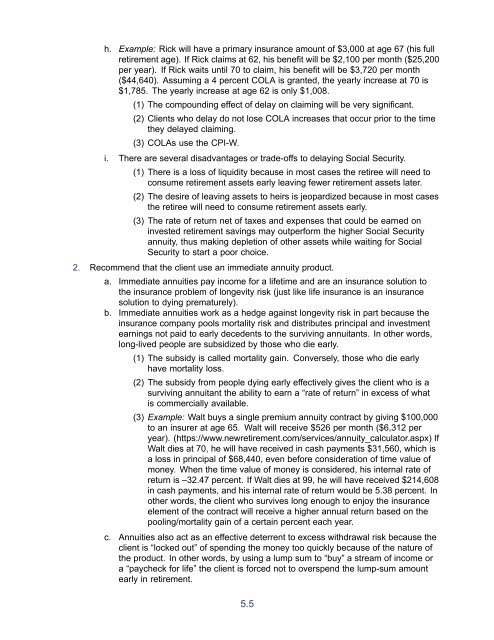section 1 - The American College Online Learning Center
section 1 - The American College Online Learning Center
section 1 - The American College Online Learning Center
You also want an ePaper? Increase the reach of your titles
YUMPU automatically turns print PDFs into web optimized ePapers that Google loves.
h. Example: Rick will have a primary insurance amount of $3,000 at age 67 (his fullretirement age). If Rick claims at 62, his benefit will be $2,100 per month ($25,200per year). If Rick waits until 70 to claim, his benefit will be $3,720 per month($44,640). Assuming a 4 percent COLA is granted, the yearly increase at 70 is$1,785. <strong>The</strong> yearly increase at age 62 is only $1,008.(1) <strong>The</strong> compounding effect of delay on claiming will be very significant.(2) Clients who delay do not lose COLA increases that occur prior to the timethey delayed claiming.(3) COLAs use the CPI-W.i. <strong>The</strong>re are several disadvantages or trade-offs to delaying Social Security.(1) <strong>The</strong>re is a loss of liquidity because in most cases the retiree will need toconsume retirement assets early leaving fewer retirement assets later.(2) <strong>The</strong> desire of leaving assets to heirs is jeopardized because in most casesthe retiree will need to consume retirement assets early.(3) <strong>The</strong> rate of return net of taxes and expenses that could be earned oninvested retirement savings may outperform the higher Social Securityannuity, thus making depletion of other assets while waiting for SocialSecurity to start a poor choice.2. Recommend that the client use an immediate annuity product.a. Immediate annuities pay income for a lifetime and are an insurance solution tothe insurance problem of longevity risk (just like life insurance is an insurancesolution to dying prematurely).b. Immediate annuities work as a hedge against longevity risk in part because theinsurance company pools mortality risk and distributes principal and investmentearnings not paid to early decedents to the surviving annuitants. In other words,long-lived people are subsidized by those who die early.(1) <strong>The</strong> subsidy is called mortality gain. Conversely, those who die earlyhave mortality loss.(2) <strong>The</strong> subsidy from people dying early effectively gives the client who is asurviving annuitant the ability to earn a “rate of return” in excess of whatis commercially available.(3) Example: Walt buys a single premium annuity contract by giving $100,000to an insurer at age 65. Walt will receive $526 per month ($6,312 peryear). (https://www.newretirement.com/services/annuity_calculator.aspx) IfWalt dies at 70, he will have received in cash payments $31,560, which isa loss in principal of $68,440, even before consideration of time value ofmoney. When the time value of money is considered, his internal rate ofreturn is –32.47 percent. If Walt dies at 99, he will have received $214,608in cash payments, and his internal rate of return would be 5.38 percent. Inother words, the client who survives long enough to enjoy the insuranceelement of the contract will receive a higher annual return based on thepooling/mortality gain of a certain percent each year.c. Annuities also act as an effective deterrent to excess withdrawal risk because theclient is “locked out” of spending the money too quickly because of the nature ofthe product. In other words, by using a lump sum to “buy” a stream of income ora “paycheck for life” the client is forced not to overspend the lump-sum amountearly in retirement.5.5
















